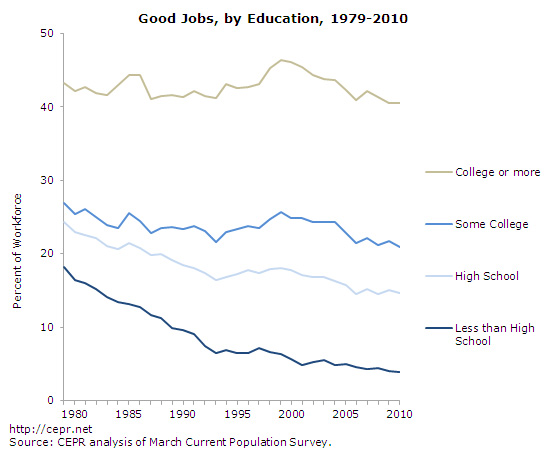August 06, 2012
Within the economics profession, the standard explanation for rising inequality over the last three decades is a shortage of college-educated workers. Technological progress, the story goes, has increased demand for highly skilled workers of the kind that colleges produce. But, young people have not been going to college in sufficient numbers to meet that demand. The result, these economists argue, is that the wages of the third or so of the workforce with a college degree have pulled ahead of the rest, creating a widening gap between the top and bottom of the income scale.
Data that Janelle Jones and I assembled for a recent CEPR report (pdf), however, raise serious doubts about this commonly held view. We analyzed trends since 1979 in “good jobs,” which we defined as one that pays at least $37,000 per year, has employer-provided health insurance, and an employer-sponsored retirement plan. We found that, overall, the share of jobs that meet these three criteria has declined since 1979 –despite a more than 60 percent increase in GDP per person.
But, what was even more surprising was that the share of workers with a college degree or more who held a good job also fell. As the figure below illustrates, in 1979, 43.2 percent of college-educated workers met our threshold; by 2010, the share had dropped to 40.5 percent. The decline is even more remarkable when you consider that the share of workers with advanced degrees (M.A., J.D., M.D., Ph.D. or similar) almost doubled over the same period, from 6.5 percent in 1979 to 11.8 percent in 2010.
If inequality is being driven by our inability to keep up with rapid technological change, wouldn’t we expect to see the share of college-educated workers with good jobs rising, not falling? Of course, workers with less education fared even worse over the same period. But, the story the figure above tells is one where something is consistently pulling the bottom out of the labor market, not one where something is pulling the top away –at least not the top as defined by broad education categories
As Janelle and I emphasize in our report, the real culprit is the systematic decline in the bargaining power of workers –reflected in a drop in the inflation-adjusted value of the minimum wage, a collapse in the unionization rate in the private-sector, the deregulation of previously well-paying industries, the privatization of state and local government jobs, a series of business-biased trade deals, a dysfunctional immigration system, poor enforcement of already weak labor standards, and high unemployment.
College-educated workers do consistently better than those with less education. But, even workers with a college degree have not been able to avoid the shift in the balance of power away from workers and toward their employers.







